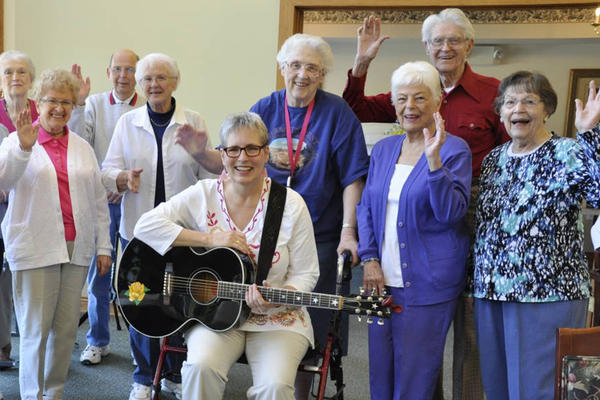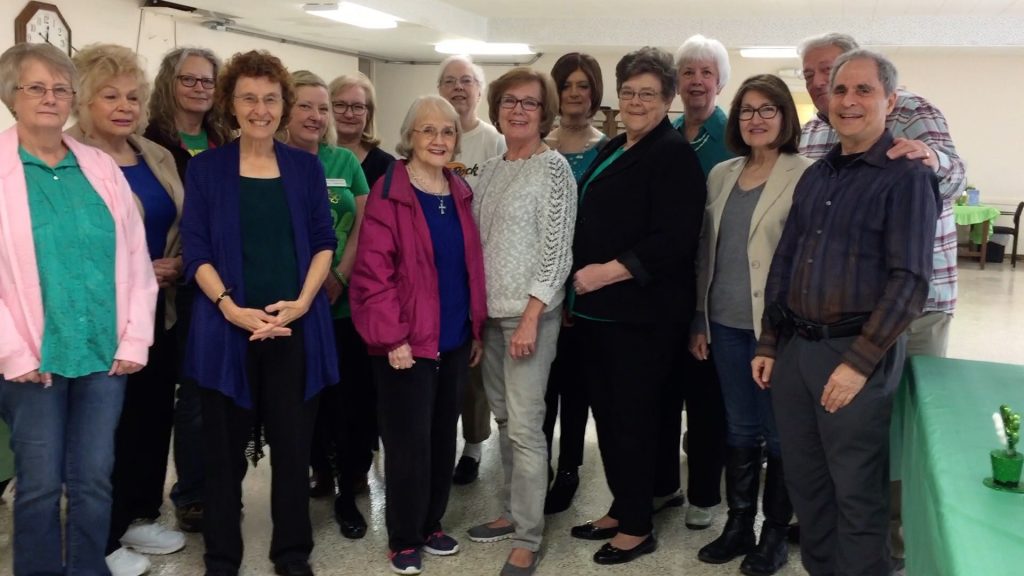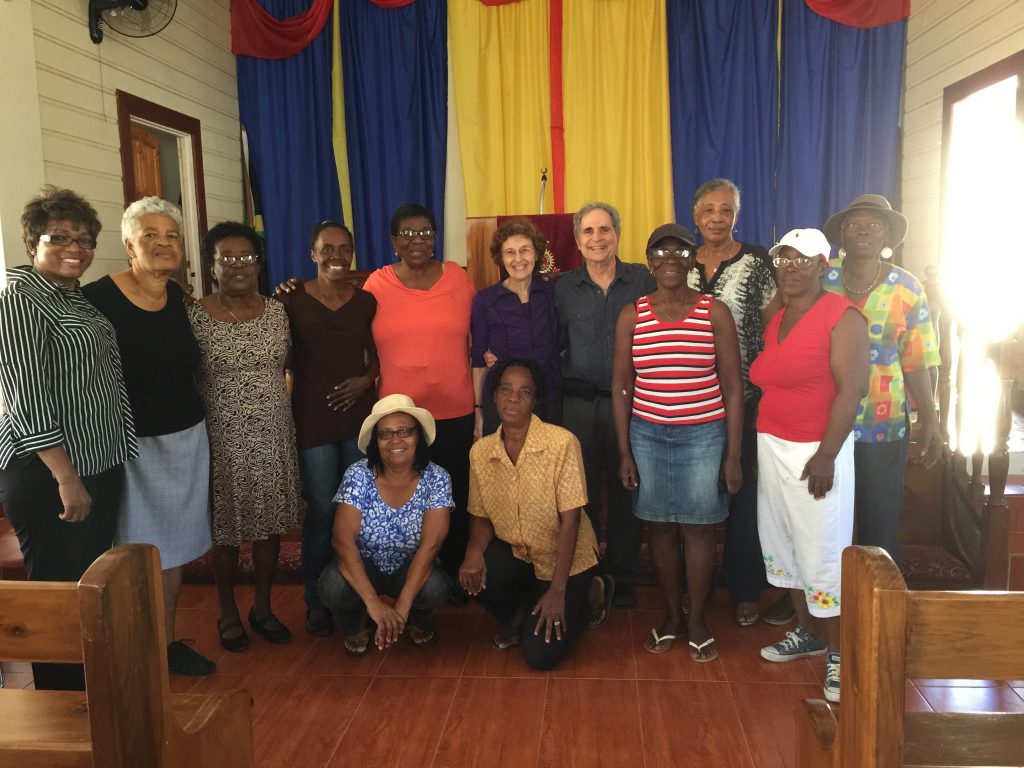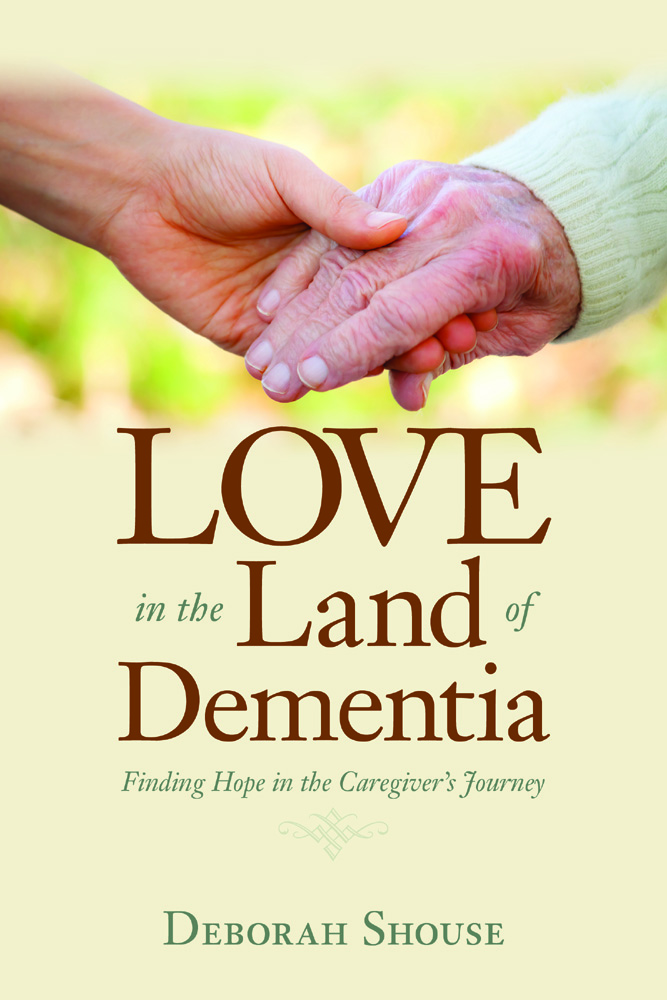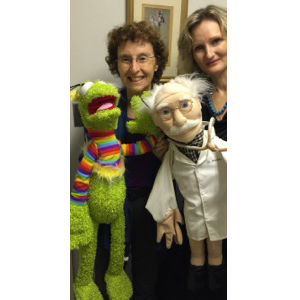Posts Tagged ‘creativity’
Five Tips for Using Music to Connect
Even as a child, I was using music to connect with my parents. My father was a DJ and my mother enjoyed show tunes and old standards. Those songs often played on our record player and we all enjoyed listening. Later, I used that same music to connect me to my mom and dad during her dementia journey.
Today, I am thrilled to sharing the insights of Mary Sue Wilkinson, Founder of Singing Heart to Heart. Just reading her ideas makes me want to burst into song.
Meaningful Visits: 5 Tips for Using Music to Connect
By: Mary Sue Wilkinson, Founder of Singing Heart to Heart
Let’s face it. Visiting someone with Alzheimer’s or dementia can be hard. You want to connect. You want to make them happy. But things have changed. I understand. I’ve been there. I found a way to connect that I’d like to share with you. Let me explain.
My father in law Virgil had dementia and eventually lost all language. The only thing he could say was “gaba gaba.” His face would light up when I came to visit. I think he knew I was someone he loved. But after the first hug and shared smile…I would flounder. Carrying on a one sided conversation only went so far. I would leave feeling lonely and discouraged. I bet he felt the same. As much as I hate to admit it, I began to put off visiting him.
Virgil had been a Church of the Brethren minister. He knew and loved all the old southern gospel songs. One day I took my guitar and began to play and sing for him. I figured I could at least entertain him for an hour or so. I started singing an old favorite: I’ll Fly Away. Virgil lifted his head, broke into a huge smile and began to sing along. Every word. Perfect pitch. He even added harmony From then on music was the focus of our visits.
It didn’t cure Virgil’s dementia. He couldn’t carry on a conversation with me when the song ended. (Although I have seen this happen with others.) But we connected in a meaningful, joyful activity. This was something we could do together. I began to look forward to our visits. I had learned that we could be together without conversation.
Have you ever hesitated to visit someone with dementia or Alzheimer’s because you were afraid you wouldn’t know what to do or what to talk about? Do you feel like you are losing your connection to your loved one or friend?
Music was the “gift” that allowed me to have meaningful, connected, and happy visits with my father-in-law. I hope that it can do the same for you. Here are some suggestions to get you started.
5 tips for using music when you visit someone with dementia
1. When dementia has progressed to the point where conversations are difficult, or even impossible – turn to music. Singing together and/or listening to music can bring happiness regardless of skill or memory. Remember that you are seeking moments of joy and connection. A shared music experience may or may not elicit shared memories. What it will do, is give you a shared experience, in the moment.
2. Bring music with you to your visit – either holiday music or music popular when they were young. Plan ahead and then share it by saying, “I brought some music I thought we could enjoy together.” If the person you are visiting does not have a CD player in their room, bring one from home, borrow one from the activity director or consider purchasing one as a gift. (You can purchase or download my CD of well known songs here.)
3. If you don’t play recorded music, you can simply sing. Even singing one or two songs will lift spirits – for everyone. It’s a great way to establish a positive mood and communicate that you are someone “good.” Choose well known and simple songs such as You Are My Sunshine, My Bonny Lies Over the Ocean, or I’ve Been Working on the Railroad. Or choose well known holiday songs or songs of faith. These songs often evoke the strongest response from people, bringing a powerful connection. (You can download my free song guides here on my website.)
4. Involve your children or grandchildren in planning a musical visit. Give them the job of figuring out what was popular when your loved one was in their 20’s and 30’s and downloading that music to play during the visit. Let them use their smart phone to make a playlist. Do they have a wireless speaker they could bring along?
If your loved one asks for a song you don’t have ready, simply go to You Tube to find it.
5. Add some energy and fun to your musical time together by patting and clapping to the beat. Don’t hesitate to dance. You may be surprised. Sometimes people can dance better than they can walk. Standing or sitting you can still “dance” together and enjoy a sweet connection.
Remember: “When words fail, music speaks.” (Hans Christian Anderson)
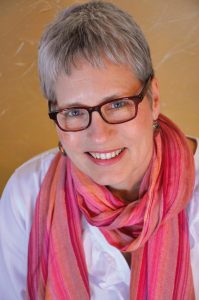 Mary Sue Wilkinson is the founder of Singing Heart to Heart where each year she leads close to 400 singing and music experiences for seniors. She specializes in using music in dementia care. Mary Sue is the author of “Songs You Know By Heart: A Simple Guide for Using Music in Dementia Care” which includes her recording of favorite sing alongs as well as a contribution from Teepa Snow. Learn more and contact Mary Sue at Singing Heart to Heart.com
Mary Sue Wilkinson is the founder of Singing Heart to Heart where each year she leads close to 400 singing and music experiences for seniors. She specializes in using music in dementia care. Mary Sue is the author of “Songs You Know By Heart: A Simple Guide for Using Music in Dementia Care” which includes her recording of favorite sing alongs as well as a contribution from Teepa Snow. Learn more and contact Mary Sue at Singing Heart to Heart.com
Deborah Shouse is the author of Connecting in the Land of Dementia: Creative Activities to Explore Together and Love in the Land of Dementia: Finding Hope in the Caregiver’s Journey.
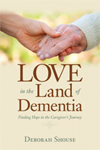

Sharing Ideas for Staying Connected
“How do we stay connected during the dementia journey?” This is a question with dozens of creative answers. Recently, we spent time at Northland Shepherd Center, hosted by Dianna Englander. We were sharing ideas for staying connected with the Together We Care Caregiver Support Group, a lovely gathering of family caregivers and friends. 
Caregiving is such a creative practice, demanding flexibility, humor, and the willingness to make mistakes and try again. We discussed ideas from Connecting in the Land of Dementia, including incorporating singing, laughter, and art into everyday life. We also explored the power of nature and talked about unique concepts for bringing the outdoors inside. We brainstormed different ways we could prepare food together and connect in the kitchen.
Here are some extra ideas we learned from our audience. I’ve changed the names to protect people’s privacy.
Anne’s father, who was normally very active, became very upset when his care facility had to temporarily curtail his movements, due to a flu outbreak.
“I want to go to the hospital,” he told the care staff repeatedly. Finally, they called Anne and asked her to come over.
“Dad was just wild,” she told us. “So I asked him to take a deep breath with me, and told him we were going to watch a basketball game before we problem-solved.” They watched an hour of basketball, which soothed both of them.
“I want to go to the hospital,” her father said.
“Why?” she asked.
“So I won’t feel alone,” he said. “I’m scared to be alone.”
Anne realized how social her father was, always walking down the hallways, greeting people, spending time visiting. She instantly began to problem solve, getting permission to walk down the corridors, wearing protective masks, gathering phone numbers of her father’s friends at the home, so he could call them.
“Taking a break and doing something soothing first really helped us figure out the problem and then solve it,” she said.
…………………….
Before her dementia advanced, Sandra’s friend loved singing in the church choir. Now, when Sandra visits her, her friend frequently asked the same question over and over. Sandra turns to beloved hymns they both know so well and when her friend becomes anxious, starts singing to change the energy. Soon, they are both singing, as they have for so many years, the old hymns guiding them back to a deep connection.
…………………….
Patriotic songs inspired Alvin’s father, Fred. So often, Fred literally tuned out the singers who came to entertain at his memory care community. One day, the group began singing “The Star Spangled Banner,” Instantly, Fred stood and put his hand over his heart. He sang along and kept standing and singing through all the familiar patriotic melodies. Afterwards, he talked about his time in the service, breaking his usual stoic silence.
At the end, we all felt a sense of renewal and companionship. Sharing these important creative ideas had enriched our lives and inspired us anew.
I’d love to hear your ideas for staying connected. Please email me at myinfo@pobox.com.
For more information about the Northland Shepherd Center, visit http://northlandsc.org/about-nsc.html
Deborah Shouse is the author of Connecting in the Land of Dementia: Creative Activities to Explore Together and Love in the Land of Dementia: Finding Hope in the Caregiver’s Journey.
Insider’s Tips for Analyzing Activities Programs
My mother had been an artist in her later years, but she stopped painting when she began living with memory loss. Instead, she took comfort in listening to music and in nurturing a baby doll. Ron’s dad studied architecture as a young man, but never had the leisure time to pursue drawing or art. When he moved into a memory care community, he flourished in the Memories in the Making painting program. We worked hard to find care homes that nurtured our parents and my background in healthcare helped us develop a few insider’s tips for analyzing activities programs.
“Families need to share information about favorite hobbies and they also need to be ready for their loved one to try new things and possibly change interests,” says Alisa Tagg, President of the National Association of Activity Professionals. Alisa has helped dozens of facilities build meaningful activity programs.
Here’s an example of how one woman thrived on learning a new skill and giving back:
Mary’s family was amazed when she got involved in a jewelry-making class in the memory care unit. Mary had never thought of making jewelry and she never even wore necklaces, bracelets, or earrings. But she loved beading and was thrilled to share her creative designs with others. Producing something beautiful for others motivated Mary. The facility helped her sell her jewelry and she contributed the money to the activities budget and also donated to charity.
Alisa knows how emotionally challenging it is for families to find good care facilities for their loved ones. Here are some of her insider’s tips for analyzing activities program.
See For Yourself
“You have to view what is going on in the activity room,” she says. “See how the staff interacts with the residents. If there’s an entertainer, is the staff in the back of the room, charting and talking? Or are they in the front, dancing, and singing and engaging with residents and families?”
Look at the activities calendar. Visit the facility at different times and on various days and see if the activities in progress match the scheduled events.
Encourage Engagement
Study the schedule to see how often the residents are engaged, rather than just being entertained. Are they invited to contribute to community service projects? Are they going to sing-alongs or helping with baking projects? People with memory deficits need a variety of activities. Look for a variety of programming that balances the four areas of wellness—spiritual, mental, physical, and emotional.
Visit Programs of Interest
Visit the programs you think your loved one might enjoy.
Find out how many staff members assist in the activities program.
Does the care staff seem aware of the importance of activities? Is there one-on-one assistance for those who want to participate and need extra attention?
Watch for Independent Projects
Is there a place for puzzles, games, cards, and other things people can enjoy independently? Are there opportunities for residents to contribute to their community and to help others around them?
Share Questions and Concerns
“Every facility should have a plan of care meeting, where family can share their expectations and concerns with the nursing staff,” Alisa says. “Ask how your loved one is doing. Share your insights.
A good facility will welcome that meeting.”
Stay Involved
Stay as involved as you can. Helping your loved one connect through meaningful activities may involve trial and error. Get to know the other residents and their families. You’ll stay engaged with your loved one and create a sense of community with a lot of other wonderful people as well. #
To learn more about Alisa Tagg, BA ACC/EDU AC-BC CADDCT CDP and the National Association of Activity Professionals, visit https://naap.info
To delve into creative activities do you can on individual visits, read my latest book, Connecting in the Land of Dementia: Creative Activities to Explore Together.
Build Community Through Sharing Stories.
Just blocks from the bustling tourist shops in the port area of Falmouth Jamaica, stands a white stucco Salvation Army Church. Inside this building, we met with local community leaders. We shared stories and information, offering ways to stay connected throughout the dementia journey. We hoped to build community through sharing stories.
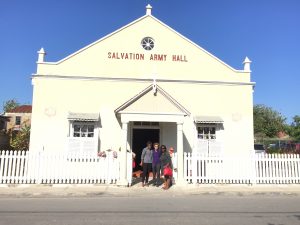
Even before we spoke, Shirley Duncan, a volunteer with Alzheimer’s Jamaica, and one of the event organizers, said, “I have a surprise for you.” She spoke eloquently of the need to talk about dementia, to share experiences, and to be there for the caregivers and people living with dementia. Then she told us that today’s participants were making a commitment to form an on-going group that would educate, advocate, and care for those affected by dementia in their community. “We are calling our group Debron, in honor of you two, because you are the catalysts,” she told us.
Ron had been working with Shirley and Dundeen Ferguson of Alzheimer’s Jamaica for several weeks, setting up the presentation. Shirley and Dahlia Klein orchestrated the details, spreading the word among the community leaders, garnering the venue, and making sure all went smoothly. We were thrilled to be catalysts and delighted to be discussing ideas with such a dedicated group of women, many of whom were former teachers.
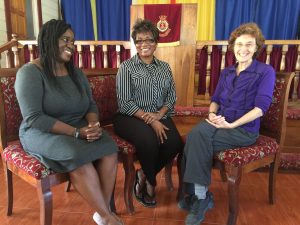 We shared ideas from Dr. Madan Kataria in Mumbai about the power of laughter yoga, and we told a story about creating an inland beach from, Dr. Claire Craig in Sheffield, England. We talked about the power of Dan Cohen’s Music & Memory program and discussed ways to connect through art, citing a story from Teri Miller in Houston, Texas. And we chatted about ways to stay connected through cooking together, sharing our own favorite childhood dishes, which included spiced shrimp, banana porridge, dumplings, roasted corn with shredded coconut, and so much more.
We shared ideas from Dr. Madan Kataria in Mumbai about the power of laughter yoga, and we told a story about creating an inland beach from, Dr. Claire Craig in Sheffield, England. We talked about the power of Dan Cohen’s Music & Memory program and discussed ways to connect through art, citing a story from Teri Miller in Houston, Texas. And we chatted about ways to stay connected through cooking together, sharing our own favorite childhood dishes, which included spiced shrimp, banana porridge, dumplings, roasted corn with shredded coconut, and so much more.
“We will spread these ideas throughout our community,” one of the women told us. “That is what teachers do, we share information.”
We left feeling so inspired and so connected. This is what we all need, caring people, compassionate and eager to learn, ready to offer help and hope.
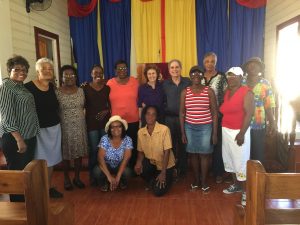
###
During our presentation, we talked about Dr. Madan Kataria’s Ha Ha chorus. At the end, the women said, “We want to sing you a song.” They serenaded us with the Ha Ha chorus. Watch this video and please, sing along.
https://drive.google.com/open?id=0B0elXRV1YrIqUkhqNzN3RkhPSUU
For more about Laughter Yoga, visit Madan Kataria’s website, http://laughteryoga.org
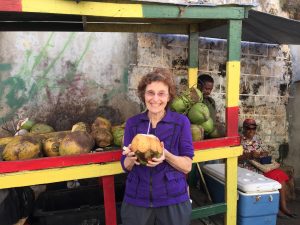
Deborah Shouse is the author of Connecting in the Land of Dementia: Creative Activities to Explore Together and Love in the Land of Dementia: Finding Hope in the Caregiver’s Journey.


Making a Difference, One Island at a Time
 “We are here to explore meaningful ways to stay connected throughout the dementia journey. We are all going to take what we’ve learned and we need the commitment of all of you to help us reach out to the families living with dementia in our communities,” Raymond Jessurun said when he introduced us at a gathering of healthcare professionals, family caregivers, and government representatives. Raymond, who is Secretary of the St. Maarten Alzheimer’s Foundation, is a passionate and inspiring speaker. He urged everyone to join as volunteers of the Alzheimer’s Foundation to spread the meaningful engagement throughout the island, making a difference, one island at a time.
“We are here to explore meaningful ways to stay connected throughout the dementia journey. We are all going to take what we’ve learned and we need the commitment of all of you to help us reach out to the families living with dementia in our communities,” Raymond Jessurun said when he introduced us at a gathering of healthcare professionals, family caregivers, and government representatives. Raymond, who is Secretary of the St. Maarten Alzheimer’s Foundation, is a passionate and inspiring speaker. He urged everyone to join as volunteers of the Alzheimer’s Foundation to spread the meaningful engagement throughout the island, making a difference, one island at a time.
As a group we discussed many engaging activities, including the joy of singing, the nurturing that animals can offer, the power of looking at art, and the creative conversations that cooking together can inspire. We strategized adding more laughter into the day and the importance of knowing each person’s musical preferences. We were also learned of the challenges family caregivers face, which in residential settings as in the Sint Martin’s Home are being addressed by professional caregivers.
 Our host, Bregje Boetekees, Director of the White and Yellow Cross Care Foundation in St. Maarten, was deeply tuned into the importance of offering an array of individualized activities and to the comfort that nature brings to those who are living with dementia. She is overseeing the construction of a new elderly care facility with a large courtyard that will offer safe and ready outdoor access, as well as fertile ground for gardening and other nature-based activities.
Our host, Bregje Boetekees, Director of the White and Yellow Cross Care Foundation in St. Maarten, was deeply tuned into the importance of offering an array of individualized activities and to the comfort that nature brings to those who are living with dementia. She is overseeing the construction of a new elderly care facility with a large courtyard that will offer safe and ready outdoor access, as well as fertile ground for gardening and other nature-based activities.
As always, we left feeling inspired by each of the people we met. Bregje and her team are constantly exploring ways to enrich the lives of their residents who are living with dementia. Raymond and the board members of the Foundation are an example of how a few compassionate and determined people can make a difference. Just eight years ago, Raymond was struggling to find his mother-in-law the dementia care she needed. His advocacy attracted other caregivers and this year their Foundation, which is recognized by Alzheimer’s Disease International, celebrates its seventh year of serving the community. In June, Raymond is co-coordinating a gathering of leaders of Alzheimer’s organizations of 15 Caribbean countries as a step to forming Alzheimer’s Caribbean. These advocates are making a difference, one caregiver at a time, one facility at a time, one island at a time.
###
We invited everyone to join us in Dr. Madan Kataria’s Ha Ha chorus. Watch this and please, sing and laugh along. Click here to view the St. Maarten HaHa Chorus
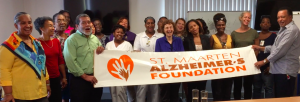
For more about Laughter Yoga, visit Madan Kataria’s website, http://laughteryoga.org
Deborah Shouse is the author of Connecting in the Land of Dementia: Creative Activities to Explore Together and Love in the Land of Dementia: Finding Hope in the Caregiver’s Journey.
Five Ways to Make Valentine’s Day Special for a Loved One with Dementia
My parents liked to celebrate Valentine’s Day with dinner and dancing. Years into my mom’s Alzheimer’s journey, my parents’ love hadn’t diminished, but my mom’s capacity for going out to dinner and dancing had drastically decreased. I saw how blue my father was—one more event he had to give up, one more change in the woman he loved—and I searched for alternatives that might cheer him up. Here are five ways to make Valentine’s Day special.
Look for a favorite thing. Seek one simple pleasure your loved one might enjoy. Mom loved potato soup and chocolate and fresh strawberries. These were part of our celebration.
Nurture yourself: include your own favorite thing. Bring yourself into the celebration and include something that makes you happy. I brought foods my father and I both liked as part of our little party.
Pick several ways to express your love. Poetry, music, gifts, flowers, and photo albums—you can use any of these resources as a catalyst to talk about your feelings. Dad and I sang Mom old show tunes and love songs, music she really enjoyed. Mom adored Shakespeare; we had a couple of sonnets on hand. She and Dad had once created a beautiful flower garden; Dad brought her a single red rose.
Take joy in the simple act of expressing yourself. Being with my mom was a chance to really practice the mythical “unconditional love.” Mom couldn’t tell me she loved me. During one Valentine’s Day celebration, she fell asleep while I was holding her hand and talking sweetly to her. But there was a comfort in expressing my love and I kept on talking.
Celebrate love in all its glorious guises. During their long marriage, my father had walked into a room millions of times and often, Mom had been busy and hadn’t particularly smiled or remarked. But with her dementia came a deep dependency on Dad. When Dad walked into a room, my mother’s face lit up. My father basked in that light. The sparkle in my mother’s eyes was the new, “I love you, darling.” The light said everything my mother could no longer say.
Deborah Shouse is the author of Connecting in the Land of Dementia: Creative Activities to Explore Together and Love in the Land of Dementia: Finding Hope in the Caregiver’s Journey.
Enjoy Dementia Inclusive Holiday Cooking
“Who prepared this delicious meal?” a friend asked during a holiday dinner.
I named my brother Dan, our head chef, first. Then I included the support team—myself, my mom, my daughters and nephews.
“Did I help?” Mom whispered as I passed her the mashed potatoes.
“You sure did,” I told her. ”You mashed the potatoes, put the marshmallows on the sweet potato casserole, and mixed the fruit salad.”
“That’s good,” she said. “I like to help.”
Our desire to help and contribute to seasonal celebrations doesn’t end with a diagnosis of dementia. It’s lovely to linger in the kitchen together, preparing food for the holidays. It’s even lovelier when you can adapt and enjoy dementia inclusive holiday cooking so that people of varying abilities can participate.
Rebecca Katz, author of The Healthy Mind Cookbook, sees food as a great equalizer, something anyone can enjoy regardless of abilities. Fixing a delicacy for someone offers a tangible and delicious way to give back.
Here are some tips so you can enjoy dementia inclusive holiday cooking.
- Leaf through a favorite family cookbook or recipe box and use the pictures and recipes as a catalyst for conversation. Ask open-ended questions, such as, ”What does that brownie recipe make you think of?” “What do you like about the holiday season?”
- Select a special recipe to make together. Choose simple, safe and satisfying tasks, such as measuring, adding ingredients , stirring, and tasting.
- Chose a time of day when you’re both rested.
- Create a comfortable kitchen environment, by playing familiar seasonal songs you can both hum or sing along to. Reduce extraneous noise and distractions, such as a television in the background.
- If you wish, take photos during the experience. That way, you can relive the adventure and share with family and friends.
- Indulge in instant gratification, if possible, by sampling your work when the cooking is complete.
- Even if the person living with dementia can’t help prepare food, he can still enjoy sitting in on the action and the conversation.
Whether you’re stirring a pot of orzo or dropping mint leaves into cool water, enjoy your time of creation and connection in the kitchen.
A longer version of this piece originally appeared on Joan Lunden’s excellent website: Enjoy Dementia Inclusive Holiday Cooking. Thanks to Sue Fitzsimmons, MS, ARNP, Judith Fertig, author of The Memory of Lemon, Kate Pierce, LMSW, Alzheimer’s Association Greater Michigan Chapter, and Rebecca Katz, author of The Healthy Mind Cookbook
Deborah Shouse is the author of Connecting in the Land of Dementia: Creative Activities to Explore Together and Love in the Land of Dementia: Finding Hope in the Caregiver’s Journey.
An Inside Look at Creative Aging
We are huddled on the floor, concentrating on our assignment. Each of us has shared an important saying or proverb that impacted our lives and now we are turning those six sayings into a song. We have a daunting five minutes to accomplish this creative task. However, we also have songwriter and musician Vanessa Torres from Lifesongs to guide us. After we've shared our sayings, Vanessa instantly comes up with a theme--These Are Things That I've Learned. Our song centers around that chorus, with each of us weaving in our personal sayings.
In the other three corners of the room, groups are collaborating, turning their sayings into spoken word, dramatic movement, and theatrical improv. Our facilitator, Susan Pearlstein, Founder Emeritus for the National Center for Creative Aging in Washington, DC, and the Founder of Elders Share the Arts in New York City, calls us back to the circle and each group performs their piece. In mere minutes, we have learned something important about each person, we have created an artistic work with people we're just getting to know, and we have appreciated the power of creating something together.
This was an exhilarating beginning to the third annual NCCA conference on creative aging.
These are things I that learned at the conference:
 Every person is inherently creative. Of course, I knew this. But it is so lovely to be reminded in so many ways. It is so lovely to be invited more deeply into your own creativity through song, dance, theater games, art, movement, and brainstorming. It's inspiring to be in a room where so many are expressively at ease with their creative spirits.
Every person is inherently creative. Of course, I knew this. But it is so lovely to be reminded in so many ways. It is so lovely to be invited more deeply into your own creativity through song, dance, theater games, art, movement, and brainstorming. It's inspiring to be in a room where so many are expressively at ease with their creative spirits.
Here are some insights from conference luminaries. Some are not attributed because I was so raptly listening I didn’t write everything down!
“Creativity is a moment when we look at the ordinary, but see the extraordinary.”
“Art is for everyone. It's not a frivolous add-on. It's a vital part of life. Everyone is creative. Dream and dispel the myth that ‘I can't do art.’ Aging has been treated like it’s all gray but it's really expansive colors.” Remarks of Jane Chu, Chairman of the National Endowment for the Arts, Sept 25th, 2016. Click here to enjoy a video of the Chairman
“Feeling useful is a human right.”
“Fifty percent of our elders feel lonely.” Vice Mayor Karsten Klein, The Hague
"By listening closely to one another, we can help illuminate the true character of this nation, reminding us all just how precious each day can be and how great it is to be alive." Dave Isay, founder of StoryCorps, via Eddie Gonzalez
“Bringing what is inside to the outside; it is important to do this as we age.” Mary Luehrsen, National Association of Music Merchants
“Creativity is the connective tissue that we use to build community across diverse differences.” Anne Basting, TimeSlips, ™ Recipient of a 2016 MacArthur Genius Grant
“Instructors need people living with dementia as co-teachers to transform educational goals. “ Dr. Elizabeth Lokon, Opening Minds Through Art
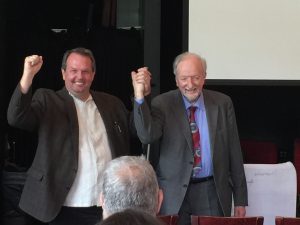
John Killick (right), poet, author and innovator in creativity and dementia, heard this wisdom one day while visiting a memory care community:
“Words of comfort are free, but very necessary.”
“I love it when you hold out your hand and water pours from it.”
“If you don't ask for the moon, you don't even get a piece of cheese.”
“You have to introduce yourself or else it all goes brittle.”
“Life is the slackness, the film and the veil.”
“Every time I look for home, I find you.”
John says, “This tells me that people with dementia are really creative and all we have to do is listen and be enriched.
This is just a soupçon of things that I learned. I wish I could have talked to every person at the conference. I wish I could have listened full on to their stories, to their sayings and proverbs, to the things that they knew and the things they had learned. Which is one reason I hope to return to the conference next year.
Deborah Shouse is the author of Connecting in the Land of Dementia: Creative Activities to Explore Together and Love in the Land of Dementia: Finding Hope in the Caregiver’s Journey.
Therapeutic Puppetry: The Best Rx is Smiles
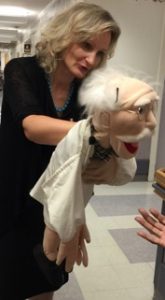 I’ve met a lot of doctors whom I admire, due to their intelligence, listening skills, willingness to collaborate, and their ability to have the occasional hearty laugh. Recently Veronica Kaninska, Certified Therapeutic Recreation Specialist, introduced me to a Doc I instantly fell in love with.
I’ve met a lot of doctors whom I admire, due to their intelligence, listening skills, willingness to collaborate, and their ability to have the occasional hearty laugh. Recently Veronica Kaninska, Certified Therapeutic Recreation Specialist, introduced me to a Doc I instantly fell in love with.
I went on rounds with Veronica and Dr. Moody, who often works with people who are living with dementia. I was so impressed with his knowledge of each individual and the warm way he offered his services. His first patient lit up when he and Veronica strolled toward her.
"How are you today?" he asked in a friendly avuncular voice. "Dr. Moody is here to check your mood. Are you feeling happy?"
"Yes, Dr. Moody, I'm happy now that you're here."
"Let me check your smile."
She smiled broadly and Dr. Moody nodded approvingly.
"Let me see your eyes."
She widened her eyes.
"Good. Your eyes are sparkling. I hope you keep your happy mood all day."
"I will Dr. Moody, I will."
We continued with Dr. Moody checking on some more patients. Each one enjoyed his company and he promised to come again and check on their moods.
After rounds, Veronica slid Dr. Moody off her arm and hung him near another popular puppet, Froggie, who she also uses for therapeutic purposes.
"People who are living with dementia often feel very comfortable communicating with puppets," Veronica says.
I wondered if Dr. Moody was open to new patients and Veronica assured me he was.
Click here to meet the good doctor. 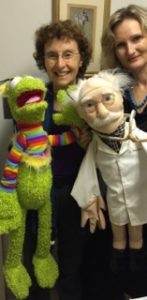
"Puppets break down barriers,” Veronica says. "They have no religion, no gender, and no judgment. People living with dementia often feel comfortable confiding in a puppet."
In a space of three to five minutes, I saw Veronica and Dr. M transform the energy of the people they visited. I asked Veronica to share a few tips for using puppets.
If you'd like to know more about Veronica and her work, read her chapter in Connecting in the Land of Dementia.
Deborah Shouse is the author of Connecting in the Land of Dementia: Creative Activities to Explore Together and Love in the Land of Dementia: Finding Hope in the Caregiver’s Journey.
Shall We Dance?
 Normally, I do not like being the center of attention. But when Sebastian Tomkowski asked me to dance the merengue, I said yes. Actually, my first reply was, "I can't dance." But Sebastian assured me he would guide me, literally, every step of the way.
Normally, I do not like being the center of attention. But when Sebastian Tomkowski asked me to dance the merengue, I said yes. Actually, my first reply was, "I can't dance." But Sebastian assured me he would guide me, literally, every step of the way.
Sebastian is one of the dancers working with Rhythm Breaks Cares (RBC), a non-profit that specializes in bringing the energy and joy of ballroom dance to people who are living with dementia. We were lucky to experience one of RBC's sessions in a New York City care facility.
When everyone was gathered in a circle, Stine Moen, one of RBC's founders, put on some Frank Sinatra tunes. Instantly, one woman danced her way into the room. Her movements were graceful and stylish. When Sebastian invited her to waltz, she readily accepted.
Stine asked a seated women if she'd like to dance. The woman said, "I have this walker and I can't dance with it."
"You can," Stine assured her. "You can use your walker and you and I can dance together."
The woman demurred and sat swaying to the music. But when Stand by Me started playing, she hoisted herself to her feet, grabbed the walker, and began moving rhythmically around the room.
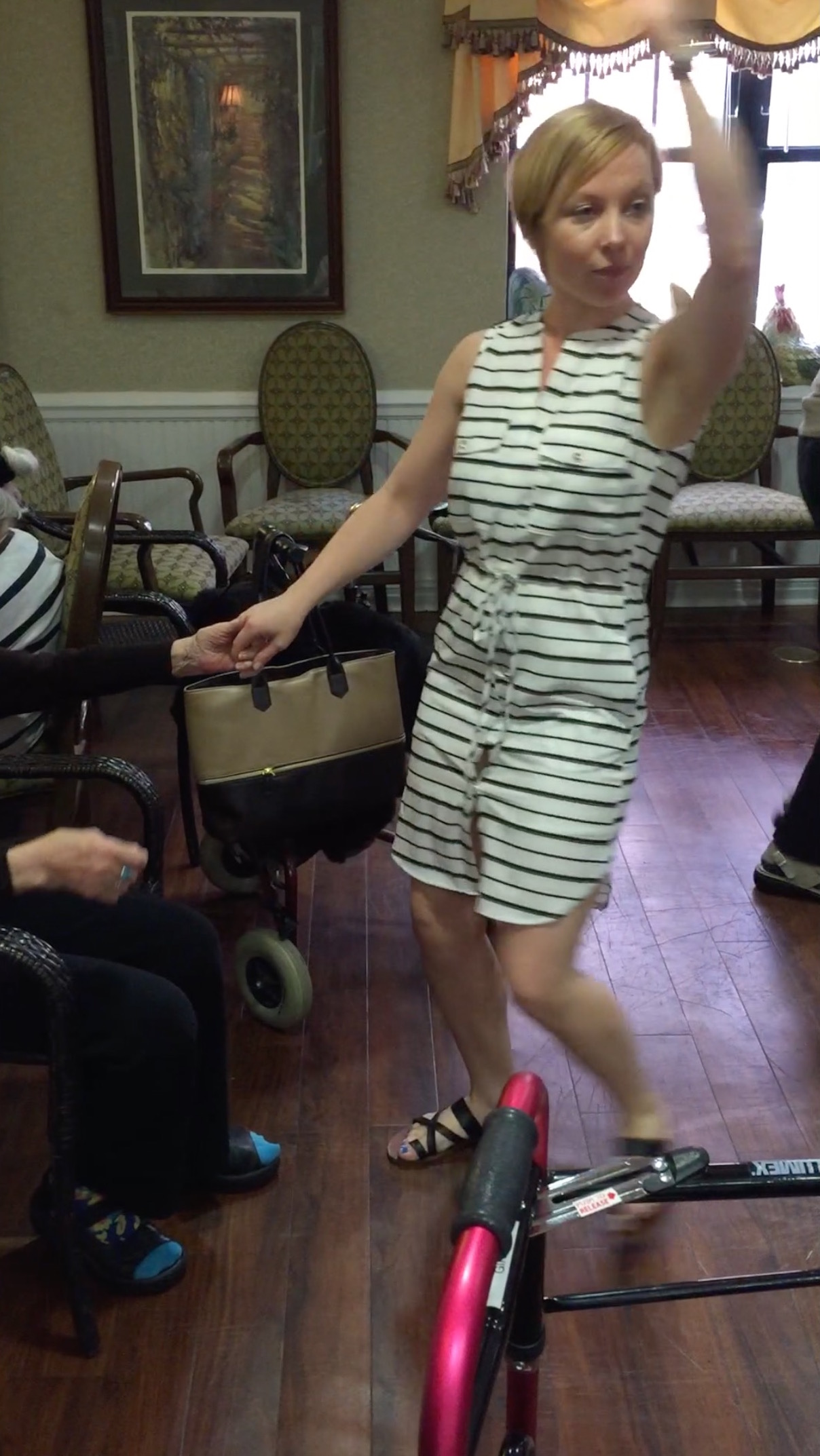 Two men sat in the circle, seemingly not registering the music. When Stine asked if they'd like to dance, one man held out his hand. Stine took his hand and let him guide the movements, while she made fancy arm gestures that looked as though they were waltzing in an elegant ballroom.Click here for dancing ideas.
Two men sat in the circle, seemingly not registering the music. When Stine asked if they'd like to dance, one man held out his hand. Stine took his hand and let him guide the movements, while she made fancy arm gestures that looked as though they were waltzing in an elegant ballroom.Click here for dancing ideas.
One woman sat stock still, but sang along when the song "Fever" played.
"I used to be a singer and my husband played the piano," she told me, when I sat beside her. "But I don't remember the words." She then proceeded to croon along with "I've Got You Under My Skin."
The energy from the music and movement seemed to engage everyone. Even a man who seemed immobile, his mouth tight, his hands clenched up near his face, gradually softened his expression and lowered his hands to his lap.As for me, I reveled in the experience, dancing with the residents or smiling and moving our hands in time to the music. And of course, I loved my once-in-a-lifetime merengue experience.
I asked Stine to offer a few tips for care partners who wanted more movement in their lives.
Here are her suggestions.
"We always start with the music." says Stine. "That sets the tone."
Once the music is playing, if possible, make eye contact. Then smile and hold out a hand. Move in ways appropriate to your partner’s abilities.
Celebrate every movement. Even swaying your arms together to the music is a form of dance.
“It's not about getting the steps right,” Stine says. “It's about connecting through music and movement.”
Want to learn more about the power of dance? Visit the RBC website. Good news—RBC offers training for qualified dancers, so they can bring this exciting program to their own communities.
Click here for additional tips from Stine.
Click here for tips from Sebastian.
Read more about creative programs in Connecting in the Land of Dementia: Creative Activities to Explore Together. Order your copy from your favorite independent or online bookstore.
Deborah Shouse is the author of Connecting in the Land of Dementia: Creative Activities to Explore Together and Love in the Land of Dementia: Finding Hope in the Caregiver’s Journey.

